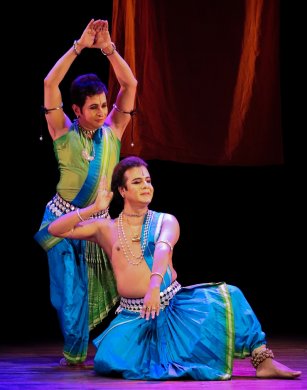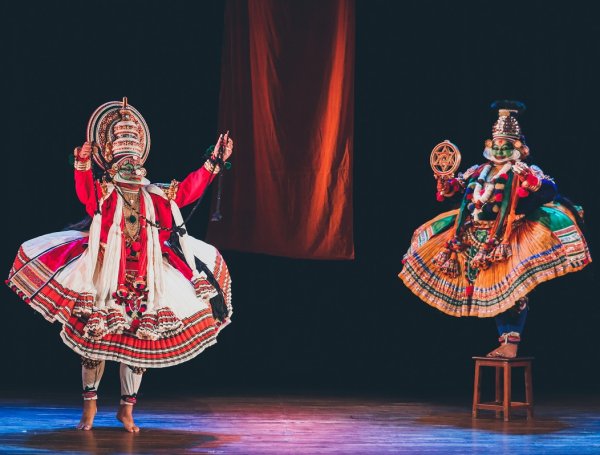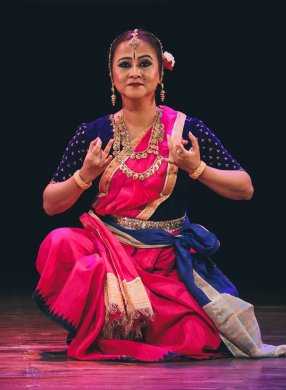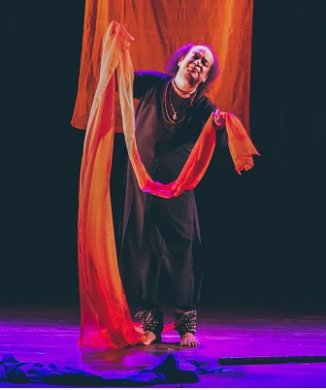
|   |

|   |
 e-mail: ukb7@rediffmail.com Re-imagining the pastoral god March 6, 2021 Krishna has always been a cause celeb in India's everyday life. Through the ages, Krishna remains, metaphorically speaking, Ghanashyam (dark as the cloud) and his amour proper Radha the 'golden fair one', to be reverentially juxtaposed -- cloud and lightning; bee and lotus; night and day. In every Indian home, a mother wakes up her child in the morning, singing much the same as mother Yashoda would have done in the mythic times. Indian bridegroom's visage is still compared to Krishna's, and the newly-weds are none other than Radha and Krishna. Millions fast on the day of Krishna's birth in Kamsa's prison, singing of the suffering that his real parents had gone through eons ago. The Krishna mythology encompasses several lilas (divine plays). Many attempts to kill the little Krishna, for instance, by demons result in Krishna vanquishing each. But these acts are not permanently quelling evil (which is impossible in the real world), but purifying them by the Lord's touch, leading to their redemption. His most alluring lilas are the countless vignettes of music and dance with the ensemble of Gopis in general and with Radha in particular, expressing the intimate relationship between god and the devotes. Krishna is viewed as various nayakas (heroes) in the Natya Shastra tradition: Dhira Udatta (gently articulate) as between himself and Arjuna; Dhira Lalita (gently soft) as in Gokul and Vrindavan; Dhira Prashanta (gently serene) as during the negotiations in the Kaurava court for the Pandavas: and Dhira Uddhata (gently arrogant) as in the encounter with Shishupala after the latter's many invectives. In the visual arts, the Krishna legend has inspired countless sculptors in the medieval period. Paintings of the Krishna theme depicted the relationship between Krishna and the Gopis in a whirlwind of spontaneous passion, which the Blue God reciprocated with equal ardor. Especially Jayadeva's Gita Govinda - constantly alluding to the marvels of nature, the allure of young womanhood and the captivating presence of Krishna -- became one of the most significant artistic sources from the 12th century onwards. The male figure of the celebrated Ragamala paintings were identified with the beautiful Krishna in later years. In the performing arts, the Krishna theme became most popular during the 15th to the 18th centuries. In dance, Vrindavan's Rasa Lila carried forward a theatrical reality, with innovative possibilities. There are innumerable festivals dotting the country, held around the Krishna theme, synchronizing with the event of his birth as well as many other incidents. The music and dance recitals are presented in village squares, sanctums of temples and urban theatres across India. Krishna is alive here and now, human and divine, sacred as well as profane, to provide a harmonious binding to the diverse graphic, plastic and performing across the entire Indian subcontinent. Ritachhanda Festival presented on the proscenium stage on February 14 by SNB Foundation, offered a bouquet of five dances, Pancha Varna, built around the Krishna theme as visualized by acharya Ashimbandhu Bhattacharya. Performed by seven senior dancers of the city, the contents did assume different hues thematically and were executed in five major classical styles.  Arnab Bandyopadhyay & Rajib Bhattacharjee Rajib Bhattacharjee and Arnab Bandyopadhyay, both groomed in Odissi in the distinctive Kelubabu gharana, took the stage first with Dashavatara (Ten Incarnations), crafted by the celebrated master himself, with music by Bhubaneswar Misra in Mohana raga and champu tala. The overture from Gita Govinda ran beautifully as: Pralaya payodhi jale dhrutavan asi Vedam / Vihita vahitra charitram akhedam / Keshava dhruta meena shareera, jaya Jagadisha hare...The dancer-duo etched many beautiful patterns for all the ten avatars in their abhinaya with excellent nritya hastas, charis and bhramaris.  Prolay Sarkar & Ramayani Roy The second item was an interesting Kathakali cameo taken from Mahabharata by Prolay Sarkar as Duryodhana and Ramayani Roy as Krishna. In this well-known episode,Krishna goes to Hastinapur to seek peace with the Kuru kingdom after the Pandavas ended their exile for 13 long years. To strike a deal between Kauravas and Pandavas, Krishna requests Duryodhana, first for half the kingdom as per their filial right; then just for five villages; and finally for even a single house, but the headstrong king rebuts all the deals, claiming that he would not yield even a needle-head of territory! His sudden attempt to arrest Krishna with a noose fails and he is left awe-struck with a revelation of Krishna's Vishwaroop (cosmic vision). The dancers need to remember that Kathakali is a highly stylised form that tries to invoke the "there and then" into the "here and now", where the characters looking straight at each other's face is strictly taboo, let alone theatrically strutting around, gesticulating and grimacing at each other.  Anita Mallick Anita Mallick took the stage next with her Krishna Anubhavam (Feelings for Krishna) which was, in effect, a Varnam and has been seen and reviewed earlier. Rendered in a ragamalika and talamalika, it was a beautifully executed item spanning Krishna's vanquishing demons like Kesi and Putana; his love-play with Gopis fetching water from river Yamuna; and ending with Vallabacharya's Madhurashtakam couplet: Nayanam madhuram, vadanam madhuram / Akhilam madhuram... Anita poured her heart into the lytic and the choreography came aglow on the stage.  Bimbavati Devi Bimbavati Devi, the penultimate dancer, is a highly accomplished Manipuri dancer and her unpretentious, yet highly evocative approach left always a deep impression on the viewer's mind. In the current composition Namah Krishnaya, a devotee offers his daily prayers to the Lord, gets immersed in her devotion and begins narrating various deeds of Krishna. A young Krishna had slayed the demons sent by Kamsa, such as Keshi, Chanura, Putana and Trinavarta; as Parthasarathi, he had guided Arjuna in the battlefield of Kurukshetra; yet, he was the one who enticed the Vrindavan maidens who yearned to be with him. The dance also depicted the beauty and grace of Krishna, with the devotee ardently praying for a relief from this mundane world. It was Bimbavati's own choreography, with the songs composed by Guru Kalavati Devi and N. Romila Devi, and instrumental music rendered by Suman Sarkar.  Ashimbandhu Bhattacharya Ashimbandhu Bhattacharya was the last dancer and took the stage by storm with a Sufi song in Kathak style: The earth is never a virgin / The monsoon rains wet it incessantly, with regular recurrence /As the dark clouds gather over the distant seas /As the rumblings of a dark unseen baritone bridge the sky and the earth /As the parched hearts eagerly prepare themselves with careful sringara / The rains come / So comes love in all its thunderous splendour / The ethereal curtain woven with diamond droplets / keep the besotted lovers under wraps / The men and birds, the animals and the inanimate all make love / Unclaimed by the fear of imminent daybreak / The Gods too celebrate the monsoon, its dark anonymity and moist arousal / preferring to prolong and never to part / The rains unite the mortals and the sublime / Rains mellow the mind, softens the soul, opens the knots... His ardent invocation of Meera's Krishna to be merged into Moula of the Sufi Pirs was joined in by the other six dancers and the performance ended with a whirligig of emotion and ecstasy. It was a captivating show!  Dr. Utpal K Banerjee is a scholar-commentator on performing arts over last four decades. He has authored 23 books on Indian art and culture, and 10 on Tagore studies. He served IGNCA as National Project Director, was a Tagore Research Scholar and is recipient of Padma Shri. Post your comments Pl provide your name and email id along with your comment. All appropriate comments posted with name and email id in the blog will also be featured in the site. |